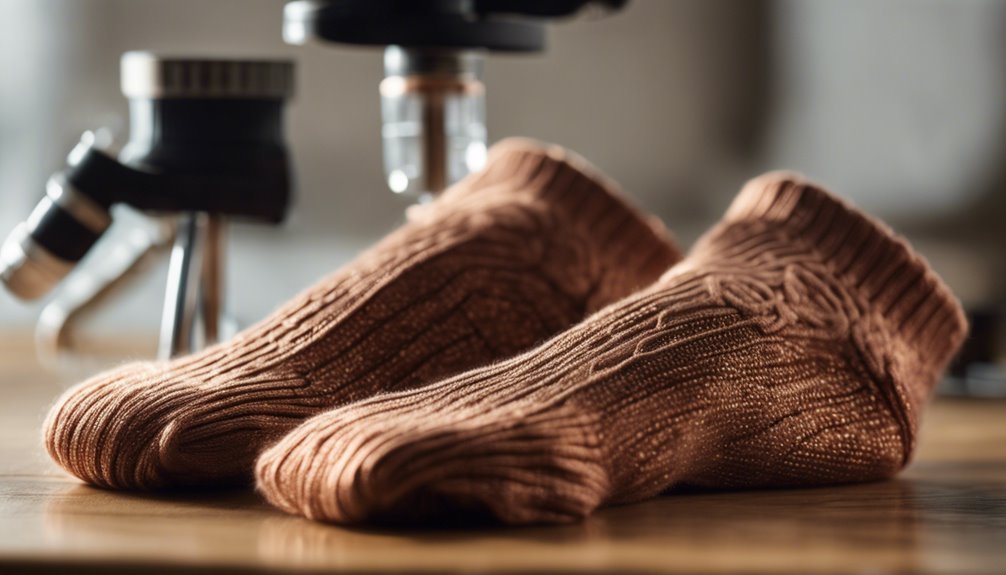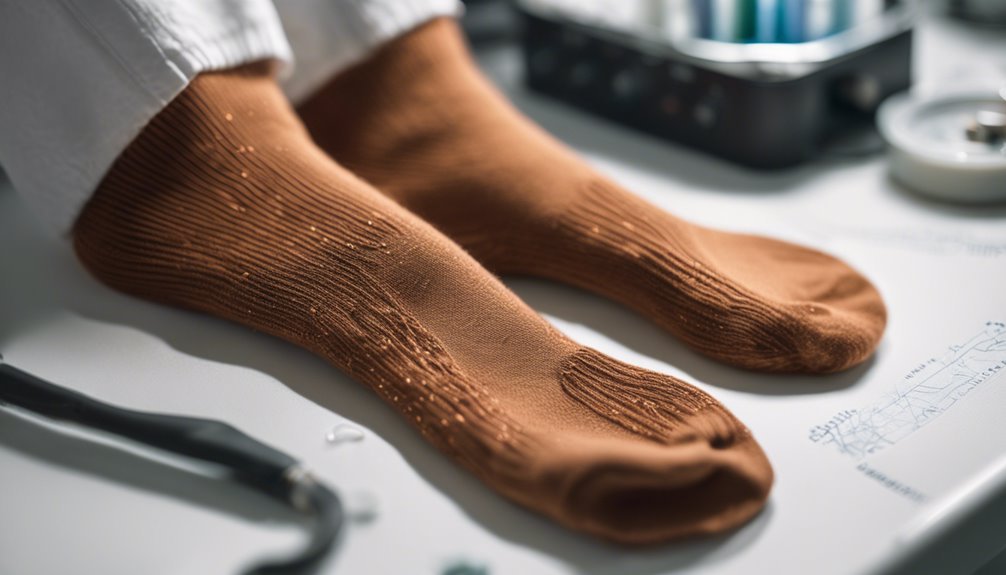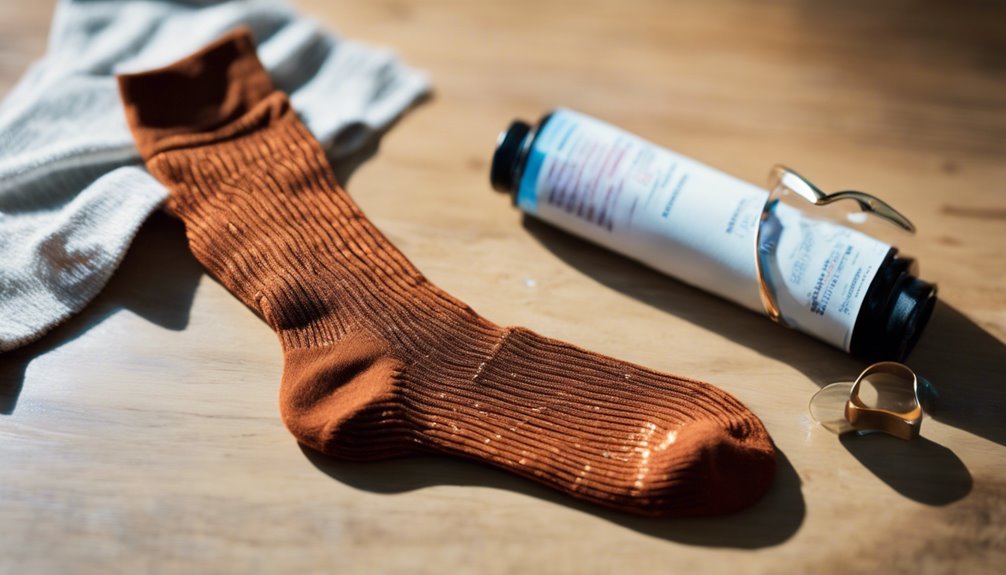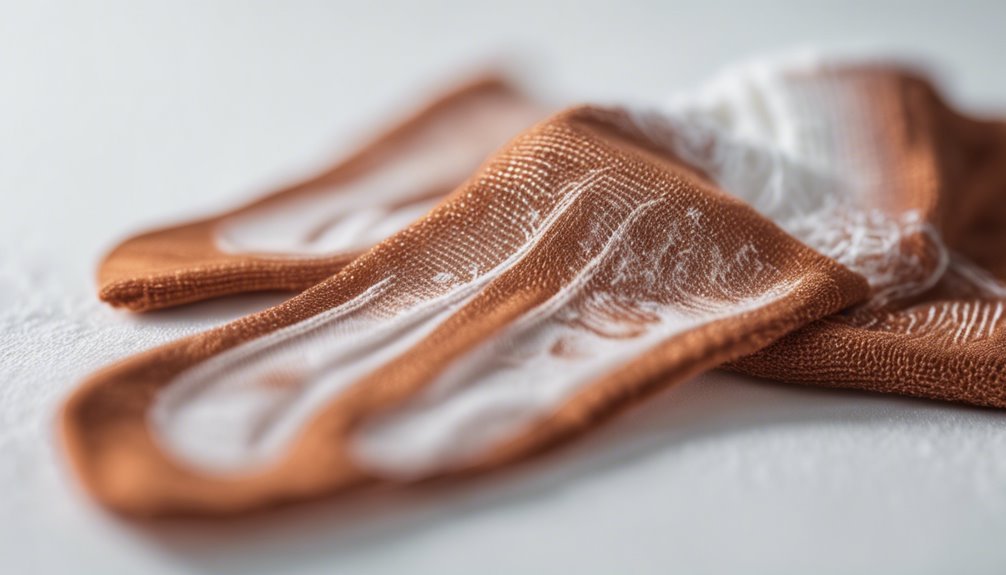Do Copper-Infused Socks Really Kill Bacteria?
Have you ever noticed how some socks seem to stay fresher longer than others? This could be due to the presence of copper-infused fibers.
Copper-infused socks leverage the antimicrobial power of copper ions, which penetrate and disrupt bacterial cell functions, effectively killing them. Laboratory studies support copper's bacterial reduction capabilities, although individual experiences vary.
Copper interacts with fabric via a specialized ionization process, enhancing lifetime and odor control. While some users find them effective, subjective feedback affects perceived benefits.
If you're curious about how copper's unique properties can further benefit your sock choice, keep exploring the topic further.
The Science Behind Copper's Antimicrobial Properties

Although you might not immediately associate copper with health benefits, its antimicrobial properties are well-documented and scientifically significant. Copper ions play an essential role in this process, disrupting key microbial cell functions. When microbes come into contact with copper surfaces, the copper ions penetrate the cell membranes. This antimicrobial mechanism is efficient in denaturing proteins and inactivating enzymes essential for microbial survival, ultimately leading to cell death. The ions create oxidative stress and generate reactive oxygen species, which further exacerbate cellular damage.
For those seeking freedom from infections, understanding this mechanism offers control over your environment. With copper's ability to combat bacteria, you can confidently embrace its use in various applications, especially in personal hygiene products like copper-infused socks, which leverage these properties effectively.
How Copper-Infused Socks Are Made
Understanding copper's antimicrobial properties naturally leads to curiosity about how these benefits are incorporated into everyday products, such as copper-infused socks. The production process includes several key manufacturing techniques that guarantee the efficacy and comfort of the final product.
- Copper Integration: Copper ions are bonded to textile fibers, often through a process called ionization, embedding the antimicrobial properties directly into the yarn.
- Spinning and Weaving: The copper-infused yarn is then spun and woven into fabric, maintaining the copper's presence throughout the sock material.
- Quality Control: Each batch undergoes rigorous testing to verify the durability and consistency of copper infusion, guaranteeing compliance with industry standards.
This meticulous process not only enhances the sock's antimicrobial capabilities but also caters to your desire for products that offer both utility and freedom from bacterial concerns.
Evaluating the Claims: Do They Really Work?

How effectively do copper-infused socks deliver on their antimicrobial claims? A vital analysis of sock longevity reveals mixed feedback. Laboratory studies suggest copper's antimicrobial properties can reduce bacterial presence, potentially extending sock lifespan. Yet, real-world effectiveness varies according to consumer reviews, highlighting inconsistent results in day-to-day use.
| Aspect | Findings |
|---|---|
| Antimicrobial Efficacy | Lab results show reduced bacteria growth. |
| Sock Longevity | Potential increased longevity; user experiences differ. |
| Consumer Reviews | Mixed; some report benefits, others see no change. |
| Real-world Testing | Inconsistent, dependent on conditions. |
While evidence supports potential benefits, freedom-seeking consumers should evaluate these against traditional options and personal experiences. It's essential to reflect on individual needs and expectations when assessing these claims. Ultimately, the effectiveness of copper-infused socks remains a subjective assessment, influenced by varied user feedback.
Comparing Copper-Infused Socks to Traditional Solutions
When comparing copper-infused socks to traditional options, it is crucial to examine the specific attributes each offers. Copper-infused socks claim enhanced benefits, particularly in sock durability and odor control. Let's break it down:
- Sock Durability: Copper fibers are touted for their strength, potentially extending the lifespan of socks compared to conventional materials. This could be appealing if you're seeking longevity and value.
- Odor Control: Copper's natural antimicrobial properties are said to reduce odor by inhibiting bacterial growth, whereas traditional socks might rely on chemical treatments that wash out over time.
- Cost-effectiveness: While copper-infused options may have a higher upfront cost, the potential for increased durability and reduced odor might mean fewer replacements, offering long-term savings.
Evaluate these factors to align with your lifestyle and preferences.
Potential Benefits and Drawbacks for Wearers

While copper-infused socks offer several potential benefits, it's essential to evaluate both the advantages and potential drawbacks they present for wearers. Enhanced comfort levels are often reported due to copper's thermal regulation properties, potentially reducing foot fatigue. However, durability concerns arise as frequent washing may degrade the copper fibers, diminishing effectiveness over time.
| Potential Benefits | Drawbacks | Analysis |
|---|---|---|
| Antimicrobial effects | Durability concerns | Longevity of effectiveness |
| Improved comfort levels | Potential skin irritation | Balance of pros and cons |
| Odor reduction | Cost implications | Value assessment |
The antimicrobial properties of copper can lead to odor reduction, yet some individuals may experience skin irritation. Cost implications may also deter you, as these socks often carry a premium price. Balancing comfort and durability is vital for making an informed decision that aligns with your need for freedom.
Factors to Consider Before Buying Copper-Infused Socks
When purchasing copper-infused socks, you should critically evaluate the material composition, as it directly affects durability and comfort. Research indicates that the antibacterial claims often associated with these socks require scrutiny to ascertain that they are substantiated by empirical evidence. It's crucial to assess the proportion of copper content and its integration with other fibers to determine the socks' efficacy and longevity.
Material Composition Matters
Although copper-infused socks promise a range of benefits from antimicrobial properties to odor control, their effectiveness largely depends on their material composition. To make informed choices, consider these factors:
- Fabric types: Look for blends that maximize copper exposure while ensuring comfort. Common materials include cotton, polyester, and nylon. Each affects durability and breathability differently.
- Copper concentration: Higher copper content generally means more potent antimicrobial action. However, balance is key, as excessive copper can reduce sock wearability.
- Moisture control: Effective moisture management is essential. Fabrics like merino wool or synthetic blends can offer superior moisture-wicking properties, reducing bacterial growth conditions.
Choosing the right combination of these elements lets you experience the desired benefits while maintaining the freedom to move comfortably.
Antibacterial Claims Validity
Understanding the material composition is critical, but equally important is evaluating the validity of antibacterial claims when considering copper-infused socks. Scrutinizing antibacterial effectiveness involves examining scientific evidence supporting copper's antimicrobial properties. Copper benefits are often highlighted, but it is crucial to distinguish marketing hype from substantiated research. Analyze studies examining copper's role in reducing bacterial load. Consider the concentration of copper ions in the fabric and whether it meets thresholds shown to inhibit microbial growth. Evaluate independent laboratory tests verifying claims, ensuring they're not solely based on manufacturer-funded research. Finally, consider the durability of antibacterial properties over time and wear. Armed with this knowledge, you can make informed decisions, prioritizing genuine effectiveness over unproven assertions, and exercise your purchasing freedom wisely.
Frequently Asked Questions
Can Copper-Infused Socks Help With Foot Odor?
Imagine slipping on socks that promise freedom from unpleasant scents. Copper-infused socks enhance foot hygiene through antimicrobial properties, aiding odor control. Evidence suggests copper ions disrupt bacterial growth, offering an innovative approach to maintaining fresh feet daily.
Are Copper-Infused Socks Safe for People With Allergies?
You might wonder if copper-infused socks pose risks for allergy reactions. Though copper is generally safe, individuals with material sensitivity should exercise caution. Analyze your skin's response and consult a specialist to guarantee comfortable, irritation-free wear.
Do Copper-Infused Socks Require Special Washing Instructions?
Ah, the irony of seeking freedom in laundry tasks. Copper-infused socks, while not demanding elaborate rituals, do benefit from gentle washing methods. For ideal fabric care, use cold water and avoid bleach to maintain their antibacterial properties.
How Long Do Copper-Infused Socks Maintain Their Effectiveness?
You're curious about copper-infused socks' effectiveness duration. Generally, their copper longevity spans several months, depending on use and care. Studies suggest diminished antimicrobial effects over time, but regular washing and proper care can extend their ideal performance.
Can Wearing Copper-Infused Socks Improve Circulation?
When your feet crave liberation, copper technology in socks might provide circulation benefits. While evidence is limited, the potential for enhanced blood flow exists. Analyze current research to decide if these socks meet your quest for improved circulation.







